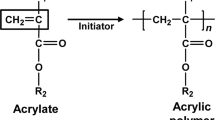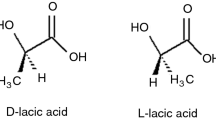Abstract
Curing of epoxy resins with aromatic amines, which provides an excellent combination of physical and mechanical properties, requires high temperatures. In this research, the amidoamine adduct of tall oil with triethylenetetramine have been used for acceleration of the reaction of the aromatic amine (diaminodiphenyl sulfone, DDS) with the diglycidyl ether of bisphenol A (DGEBA) epoxy resin. The kinetics of the curing reaction of DGEBA with a mixture of two hardeners was investigated by the non-isothermal DSC method. It was shown that the activation energy of curing decreased from ~ 68 to ~ 59 kJ/mole at amidoamine introduction. Nevertheless, there were no new bands in the IR-spectra of the cured epoxy resins. The acceleration of the curing reaction of the aromatic amine was apparently due to the autocatalytic action of the hydroxyl groups formed by the reaction of the epoxy resin with the amidoamine. Besides acceleration of curing, use of the hardener mixture significantly increased the rubbery-plateau modulus, while not influencing on the value of the elasticity modulus of the cured resin in the glassy state. A disadvantage of using amidoamine for accelerating the curing was lowering of the glass transition temperature of the cured polymer.
Graphical abstract













Similar content being viewed by others
References
Ellis B (1993) Chemistry and technology of epoxy resins, 1st edn. Blackie Academic & Professional, New York, pp 37–71
Prime RB, Sacher E (1972) Kinetics of epoxy cure: 2. The system bisphenol-A diglycidyl ether/polyamide. Polymer 13:455–458. https://doi.org/10.1016/0032-3861(72)90113-9
Prime RB (1973) Differential scanning calorimetry of the epoxy cure reaction. J Polym Eng Sci 13:365–371. https://doi.org/10.1002/pen.760130508
Dang ZM, Zhang B, Li J, Zha JW, Hu GH (2012) Copper particles/epoxy resin thermosetting conductive adhesive using polyamide resin as curing agent. J Appl Polym Sci 126:815–821. https://doi.org/10.1002/app.36951
Han CH, Wang L, Zhao DY (2014) Curing process of epoxy resin using low molecular polyamide 651 as curing agent. Adv Mater Res 936:63–66. https://doi.org/10.4028/www.scientific.net/AMR.936.63
Hong SG, Tsai JS (2000) The effect of metal surfaces on the adsorption and degradation behavior of an epoxy/amidoamine system. Macromol Mater Eng 276:59–65. https://doi.org/10.1002/(SICI)1439-2054(20000301)276:1%3c59:AID-MAME59%3e3.0.CO;2-O
Qaderi SBA, Peck MC, Bauer DR (1987) Characterization of solutions and aqueous dispersions of epoxy/amidoamine resins. J Appl Polym Sci 34:2313–2323. https://doi.org/10.1002/app.1987.070340621
Morgan RJ (1979) The effect of thermal history and strain rate on the mechanical properties of diethylenetriamine-cured bisphenol-A-diglycidyl ether epoxies. J Appl Polym Sci 23:2711–2717. https://doi.org/10.1002/app.1979.070230916
Yuan YC, Rong MZ, Zhang MQ, Chen J, Yang GC, Li XM (2008) Self-healing polymeric materials using epoxy/mercaptan as the healant. Macromolecules 41:5197–5202. https://doi.org/10.1021/ma800028d
Laza JM, Julian CA, Larrauri E, Rodriguez M, Leon LM (1999) Thermal scanning rheometer analysis of curing kinetic of an epoxy resin: 2. An amine as curing agent. Polymer 40:35–45. https://doi.org/10.1016/S0032-3861(98)00217-1
Galego N, Vazquez A, Riccardi CC, Williams RJ (1992) Citric acid–diethylenetriamine salts as latent curing agents for epoxy resins. J Appl Polym Sci 45:607–610. https://doi.org/10.1002/app.1992.070450407
Petrie EM (2006) Epoxy adhesive formulations. McGraw-Hill Chemical Engineering, New York, pp 203–233
Barton JM (1986) Differential scanning calorimetry cure studies of tetra-N-glycidyldiaminodiphenylmethane epoxy resins. Part 1—reaction with 4,4′-diaminodiphenylsulphone. Polymer Int 18:37–43. https://doi.org/10.1002/pi.4980180110
Barton JM (1986) Differential scanning calorimetry cure studies of tetra-N-glycidyldiaminodiphenylmethane epoxy resins part 2—reaction with 4,4′-diaminodiphenylsulphone accelerated by borontriofluoride-ethylamine. Polymer Int 18:44–50. https://doi.org/10.1002/pi.4980180111
Ilyin SO, Brantseva TV, Kotomin SV, Antonov SV (2018) Epoxy nanocomposites as matrices for aramid fiber‐reinforced plastics. Polym Compos 39:E2167–E2174. https://doi.org/10.1002/pc.24515
Brantseva TV, Solodilov VI, Antonov SV, Gorbunova IY, Korohin RA, Shapagin AV, Smirnova NM (2016) Epoxy modification with poly (vinyl acetate) and poly (vinyl butyral). I. Structure, thermal, and mechanical characteristics. J Appl Polym Sci 133:44081–44094. https://doi.org/10.1002/app.44081
Ilyin SO, Brantseva TV, Gorbunova IY, Antonov SV, Korolev YM, Kerber ML (2015) Epoxy reinforcement with silicate particles: rheological and adhesive properties—part I: characterization of composites with natural and organically modified montmorillonites. Int J Adhes Adhes 61:127–136. https://doi.org/10.1016/j.ijadhadh.2015.05.008
Brantseva TV, Ilyin SO, Gorbunova IY, Antonov SV, Korolev YM, Kerber ML (2016) Epoxy reinforcement with silicate particles: rheological and adhesive properties-part II: characterization of composites with halloysite. Int J Adhes Adhes 68:248–255. https://doi.org/10.1016/j.ijadhadh.2016.04.005
Brantseva TV, Antonov SV, Gorbunova IY (2018) Adhesion properties of the nanocomposites filled with aluminosilicates and factors affecting them: a review. Int J Adhes Adhes 82:263–281. https://doi.org/10.1016/j.ijadhadh.2018.01.001
Yang SY, Lin WN, Huang YL, Tien HW, Wang JY, Ma CCM, Li SM, Wang YS (2011) Synergetic effects of graphene platelets and carbon nanotubes on the mechanical and thermal properties of epoxy composites. Carbon 49:793–803. https://doi.org/10.1016/j.carbon.2010.10.014
Anwar Z, Kausar A, Rafique I, Muhammad B (2015) Advances in epoxy/graphene nanoplatelet composite with enhanced physical properties: a review. Polym-Plast Technol Eng 55:643–662. https://doi.org/10.1080/03602559.2015.1098695
Wei J, Vo T, Inam F (2015) Epoxy/graphene nanocomposites–processing and properties: a review. RSC Adv 5:73510–73524. https://doi.org/10.1039/C5RA13897C
Martinez I, Martin MD, Eceiza A, Oyanguren P, Mondragon I (2000) Phase separation in polysulfone-modified epoxy mixtures. Relationships between curing conditions, morphology and ultimate behavior. Polymer 41:1027–1035. https://doi.org/10.1016/S0032-3861(99)00238-4
Min BG, Hodgkin JH, Stachurski ZH (1993) Reaction mechanisms, microstructure, and fracture properties of thermoplastic polysulfone-modified epoxy resin. J Appl Polym Sci 50:1065–1073. https://doi.org/10.1002/app.1993.070500615
Antonov AV, Zelenskiy ES, Kuperman AM (2003) Impact resistance of reinforced plastics based on polysulfone-epoxy blends. J Reinf Plast Compos 22:361–372. https://doi.org/10.1177/0731684403022004839
Teng KC, Chang FC (1996) Single-phase and multiple-phase thermoplastic/thermoset polyblends: 2. Morphologies and mechanical properties of phenoxy/epoxy blends. Polymer 37:2385–2394. https://doi.org/10.1016/0032-3861(96)85350-X
Mimura K, Ito H, Fujioka H (2000) Improvement of thermal and mechanical properties by control of morphologies in PES-modified epoxy resins. Polymer 41:4451–4459. https://doi.org/10.1016/S0032-3861(99)00700-4
Bucknall CB, Partridge IK (1983) Phase separation in epoxy resins containing polyethersulphone. Polymer 24:639–644. https://doi.org/10.1016/0032-3861(83)90120-9
Korokhin RA, Solodilov VI, Gorbatkina YA, Shapagin AV (2015) Rheological and physicomechanical properties of epoxy-polyetherimide compositions. Mech Compos Mater 51:313–320. https://doi.org/10.1007/s11029-015-9502-y
Arinina MP, Ilyin SO, Makarova VV, Gorbunova IY, Kerber ML, Kulichikhin VG (2015) Miscibility and rheological properties of epoxy resin blends with aromatic polyethers. Polym Sci Ser A 57:177–185. https://doi.org/10.1134/S0965545X15020017
Smith JDB (1981) Metal acetylacetonates as latent accelerators for anhydridehyphen; cured epoxy resins. J Appl Polym Sci 26:979–986. https://doi.org/10.1002/app.1981.070260320
Smith JDB (1979) Quaternary phosphonium compounds as latent accelerators for anhydride-cured epoxy resins. I. Latency and cure characteristics. J Appl Polym Sci 23:1385–1396. https://doi.org/10.1002/app.1979.070230510
Ogata M, Kinjo N, Eguchi S, Hozoji H, Kawata T, Sashima H (1992) Effects of curing accelerators on physical properties of epoxy molding compound (EMC). J Appl Polym Sci 44:1795–1805. https://doi.org/10.1002/app.1992.070441012
Paz-Abuin S, Lopez-Quintela A, Pellin MP, Varela M, Prendes P (1998) Autoacceleration and inhibition: free volume. Epoxy-amine kinetics. J Polym Sci, A: Polym Chem 36:1001–1016. https://doi.org/10.1002/(SICI)1099-0518(19980430)36:6%3c1001:AID-POLA15%3e3.0.CO;2-9
González M, Kindelán M, Cabanelas JC, Baselga J (2003) Modelling auto-acceleration in DGEBA/diamine systems. J Macromol Symp 200:111–120. https://doi.org/10.1002/masy.200351011
Mohan P (2013) A critical review: the modification, properties and applications of epoxy resin. Polym-Plast Technol Eng 52:107–125. https://doi.org/10.1080/03602559.2012.727057
Grillet AC, Galy J, Gérard JF, Pascault JP (1991) Mechanical and viscoelastic properties of epoxy networks cured with aromatic diamines. Polymer 32:1885–1891. https://doi.org/10.1016/0032-3861(91)90380-2
Grillet AC, Galy J, Pascault JP, Bardin I (1989) Effects of the structure of the aromatic curing agent on the cure kinetics of epoxy networks. Polymer 30:2094–2103. https://doi.org/10.1016/0032-3861(89)90300-5
Eselev AD, Bobylev VA (2007) State-of-the-art production of epoxy resins and adhesive hardeners in Russia. Polym Sci Ser C 49:22–27. https://doi.org/10.1134/S1811238207010055
Galy J, Sabra A, Pascault JP (1986) Characterization of epoxy thermosetting systems by differential scanning calorimetry. Polym Eng Sci 26:1514–1523. https://doi.org/10.1002/pen.760262108
Satyarthi JK, Srinivas D, Ratnasamy P (2009) Estimation of free fatty acid content in oils, fats, and biodiesel by 1H NMR spectroscopy. Energy Fuels 23:2273–2277. https://doi.org/10.1021/ef801011v
Ahlers NHE, Brett RA, McTaggart NG (1953) An infra-red study of the cis-and trans-isomers of some c18 fatty acids. J Appl Chem 3:433–443. https://doi.org/10.1002/jctb.5010031002
Prolongo SG, del Rosario G, Urena A (2005) Comparative study on the adhesiveproperties of different epoxy resins. Int J Adhes Adhes 26:125–132. https://doi.org/10.1016/j.ijadhadh.2005.02.004
Kamal MR, Sourour S (1973) Kinetics and thermal characterization of thermoset cure. Polym Eng Sci 13:59–64. https://doi.org/10.1002/pen.760130110
Musto P, Martuscelli E, Ragosta G, Russo P, Villano P (1999) Tetrafunctional epoxy resins: modeling the curing kinetics based on FTIR spectroscopy data. J Appl Polym Sci 74:532–540. https://doi.org/10.1002/(sici)1097-4628(19991017)74:3%3c532:aid-app8%3e3.0.co;2-q
Kissinger HE (1957) Reaction kinetics in differential thermal analysis. J Anal Chem 29:1702–1706. https://doi.org/10.1021/ac60131a045
Zvetkov VL, Djoumaliisky S, Simeonova-Ivanova E (2013) The non-isothermal DSC kinetics of polyethylene tereftalate–epoxy compatible blends. Thermochim Acta 553:16–22. https://doi.org/10.1016/j.tca.2012.11.026
Arinina MP, Kostenko VA, Gorbunova IY, Il’in SO, Malkin AY (2018) Kinetics of curing of epoxy oligomer by diaminodiphenyl sulfone: rheology and calorimetry. Polym Sci Ser A 60:683–690. https://doi.org/10.1134/S0965545X18050012
Ozawa T (1970) Kinetic analysis of derivative curves in thermal analysis. J Thermal Anal Cal 2:301–324. https://doi.org/10.1007/BF01911411
Ferdosian F, Yuan Z, Anderson M, Xu CC (2015) Sustainable lignin-based epoxy resins cured with aromatic and aliphatic amine curing agents: curing kinetics and thermal properties. Thermochim Acta 618:48–55. https://doi.org/10.1016/j.tca.2015.09.012
Sbirrazzuoli N, Mititelu-Mija A, Vincent L, Alzina C (2006) Isoconversional kinetic analysis of stoichiometric and off-stoichiometric epoxy-amine cures. Thermochim Acta 447:167–177. https://doi.org/10.1016/j.tca.2006.06.005
Ngo T, Hoa SV, Cole KC (2007) Curing kinetics and mechanical properties of epoxy nanocomposites based on different organoclays. Polym Eng Sci 47:649–661. https://doi.org/10.1002/pen.20737
Cai H, Li P, Sui G, Yu Y, Li G, Yang X, Ryu S (2008) Curing kinetics study of epoxy resin/flexible amine toughness systems by dynamic and isothermal DSC. Thermochim Acta 473:101–105. https://doi.org/10.1016/j.tca.2008.04.012
Smith RE, Larsen FN, Long CL (1984) Epoxy resin cure. II. FTIR analysis. J Appl Polym Sci 29:3713–3726. https://doi.org/10.1002/app.1984.070291207
Gao L, Wang J (2017) Thermal, mechanical, and dielectric studies on the DGEBA epoxy blends by using liquid oxidized poly (1, 2-butadiene) as a reactive component. J Appl Polym Sci. https://doi.org/10.1002/app.44689
Cole KC, Hechler JJ, Noel D (1991) A new approach to modeling the cure kinetics of epoxy/amine thermosetting resins. 2. Application to a typical system based on bis [4-(diglycidylamino) phenyl] methane and bis (4-aminophenyl) sulfone. Macromolecules 24:3098–3110. https://doi.org/10.1021/ma00011a012
Wu X, Yang X, Yu R, Zhao XJ, Zhang Y, Huang W (2018) Highly crosslinked and uniform thermoset epoxy microspheres: preparation and toughening study. Polymer 143:145–154. https://doi.org/10.1016/j.polymer.2018.04.011
Wu L, Hoa SV, Tan M, That T (2006) Effects of composition of hardener on the curing and aging for an epoxy resin system. J Appl Polym Sci 99:580–588. https://doi.org/10.1002/app.22493
Kim T, Kim S, Lee DG, Lim CS, Seo B (2018) Preparation of a branched amine and physical and thermal studies of epoxy compositions including the amine compound. J Appl Polym Sci 135:46233. https://doi.org/10.1002/app.46233
Srikanth A, Vergara J, Palmese G, Abrams CF (2017) The effect of alkyl chain length on material properties of fatty-acid-functionalized amidoamine-epoxy systems. Eur Polym J 89:1–12. https://doi.org/10.1016/j.eurpolymj.2017.01.037
Pascault JP, Sautereau H, Verdu J, Williams RJ (2002) Thermosetting polymers. Marcel Dekker, New York
Nabeth B, Pascault JP, Dusek K (1996) Concept of hard clusters in the interpretation of thermal and mechanical properties of polyurethane and polyurethane acrylate networks. J Polym Sci, B: Polym Phys 34:1031–1054. https://doi.org/10.1002/(SICI)1099-0488(19960430)34:6%3c1031:AID-POLB2%3e3.0.CO;2-0
Author information
Authors and Affiliations
Corresponding author
Additional information
Publisher's Note
Springer Nature remains neutral with regard to jurisdictional claims in published maps and institutional affiliations.
The authors are grateful to Dr. M. Filatova for registration of NMR-spectrum. This research was carried out within the State Program of A.V. Topchiev Institute of Petrochemical Synthesis.
Rights and permissions
About this article
Cite this article
Ignatenko, V.Y., Ilyin, S.O., Kostyuk, A.V. et al. Acceleration of epoxy resin curing by using a combination of aliphatic and aromatic amines. Polym. Bull. 77, 1519–1540 (2020). https://doi.org/10.1007/s00289-019-02815-x
Received:
Revised:
Accepted:
Published:
Issue Date:
DOI: https://doi.org/10.1007/s00289-019-02815-x




